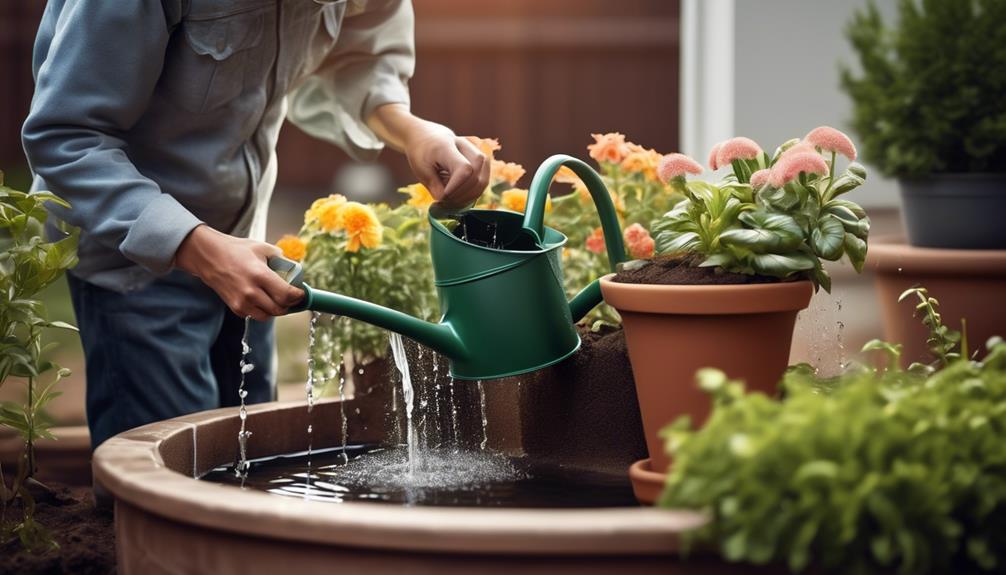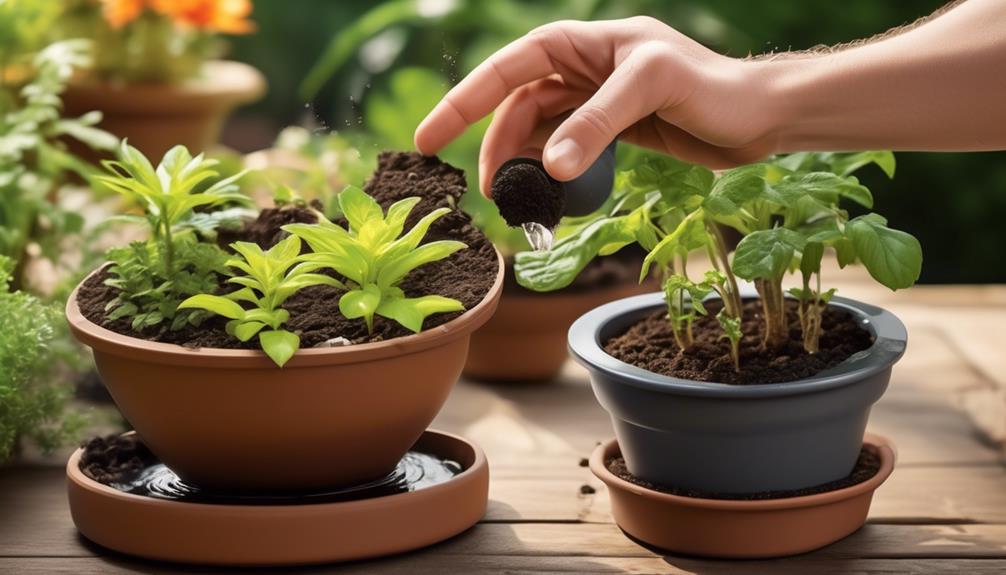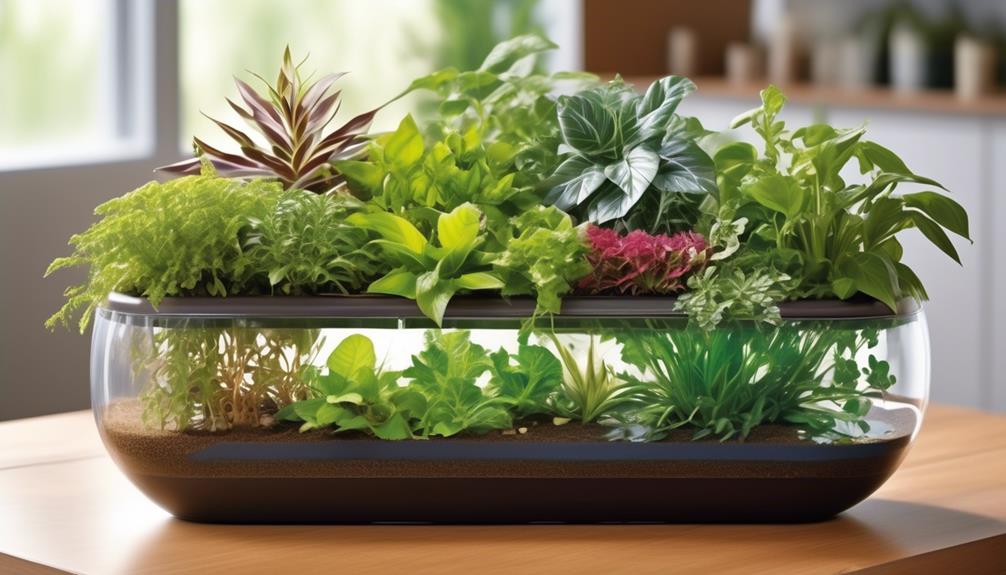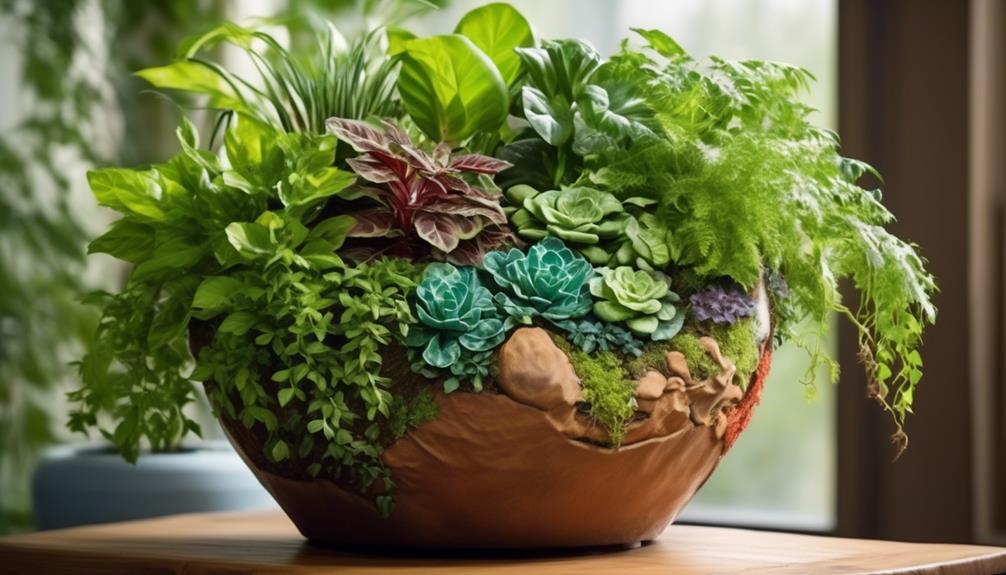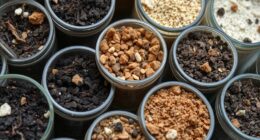In the gardening realm, there is a popular saying: “a watched pot never boils.” However, when it comes to self-watering planters, keeping a close eye on them is essential. It can be a struggle to make sure our plants get enough water, especially during busy times or when we are on vacation.
But fear not, because self watering planters offer a convenient solution to this common problem. So, how exactly do we harness the power of these innovative planters to ensure our greenery thrives without the constant worry of watering?
Key Takeaways
- Self-watering planters have a reservoir at the bottom filled with water.
- Select the right soil mix with a balanced composition of organic matter, perlite, and vermiculite.
- Choose plants that thrive in well-draining soil and are suited for indoor environments.
- Regularly monitor the water level indicator and adjust watering frequency based on seasonal changes.
Understanding the Self Watering Planter
We've found that understanding the self-watering planter involves comprehending how its unique design and mechanism work to provide consistent moisture to the plants. The key to its functionality lies in the reservoir at the bottom of the planter. This reservoir is filled with water and has a wicking system that allows the soil to draw up water as needed, ensuring optimal hydration for the plants. The design prevents overwatering by allowing the plants to uptake water through capillary action, which is governed by the moisture level in the soil. This mechanism is essential for maintaining the plants' health and vitality.
Planter maintenance is crucial for the self-watering planter to function effectively. Regular checks of the water level in the reservoir and topping it up when necessary are essential. Additionally, periodic cleaning of the reservoir prevents the growth of algae or mold, ensuring a healthy environment for the plants. Understanding these maintenance requirements is vital for the long-term success of the self-watering planter.
In mastering the use of a self-watering planter, comprehending its unique design, mechanism, and maintenance is fundamental for achieving consistent and optimal plant hydration.
Selecting the Right Soil Mix
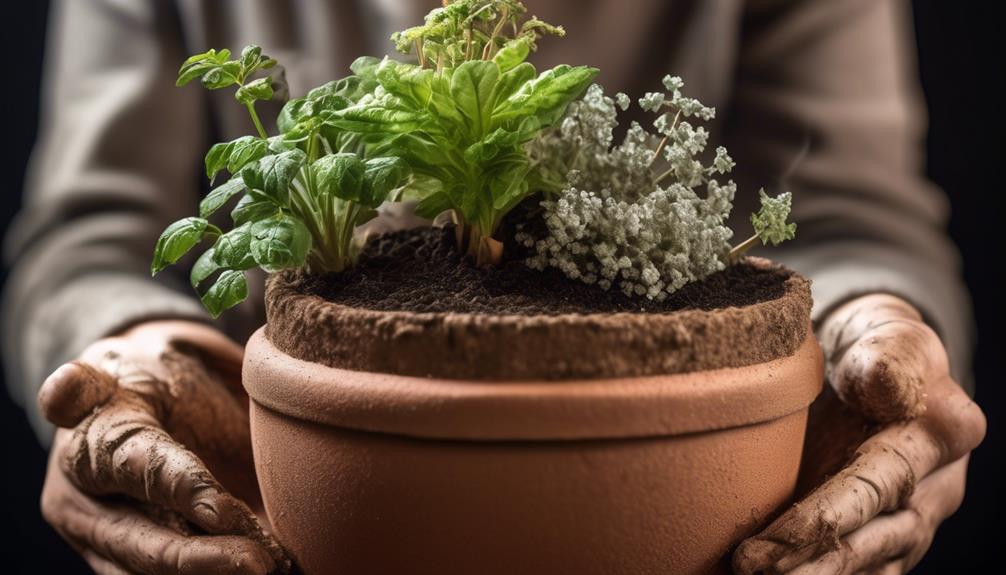
Selecting the right soil mix for a self-watering planter is crucial to ensure proper hydration and optimal growth for your plants. The soil mix should have a balanced composition of organic matter, perlite, and vermiculite to promote healthy root development and efficient water distribution. When selecting a soil mix, consider its ability to retain moisture while also providing adequate aeration to the roots.
Look for a mix that's rich in essential soil nutrients such as nitrogen, phosphorus, and potassium to support robust plant growth.
A well-draining soil mix is essential for preventing waterlogging, which can lead to root rot and other moisture-related issues. Additionally, the soil mix should have the capacity to hold onto water for longer periods, reducing the frequency of watering. This is particularly important for self-watering planters, as it helps maintain a consistent moisture level within the planter.
Planting Your Greenery
When it comes to planting your greenery in the self-watering planter, it's important to build upon the foundation of the right soil mix to ensure the best conditions for your plants' growth. Choosing the right plants is crucial for successful self-watering planter gardening. Opt for plants that thrive in well-draining soil and are suited for indoor environments. Herbs like basil, mint, and thyme, as well as small vegetables such as cherry tomatoes and lettuce, are popular choices. Consider the mature size of the plants and ensure they'll have ample space to grow within the planter.
Proper placement within your home is also essential. Analyze the light conditions in your living space to determine the best location for your self-watering planter. Most plants require ample sunlight, so it's advisable to place the planter near a south-facing window. However, if natural light is limited, consider using artificial grow lights to supplement the plants' light requirements.
Once you've selected the right plants and found the optimal placement within your home, it's time to carefully plant them in the self-watering planter. Follow the planting instructions for each specific plant, taking care not to overcrowd the planter. Proper planting ensures that your greenery will thrive and benefit from the self-watering system.
Adding Water to the Reservoir
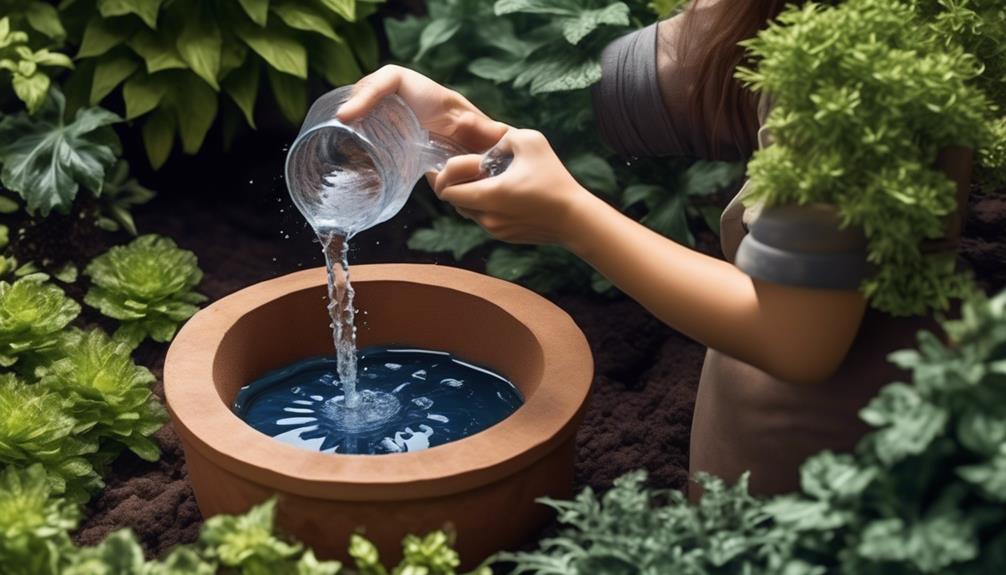
To ensure proper functioning of the self-watering planter, it is essential to carefully add water to the reservoir, maintaining the ideal moisture levels for your plants' growth. Proper reservoir maintenance and watering frequency are crucial for the health of your plants. When adding water to the self-watering planter, it's important to consider the type of plant, its water requirements, and the environmental conditions. Here's a helpful guide to ensure you're adding water effectively:
| Aspect | Consideration | Action |
|---|---|---|
| Water Level | Check regularly | Keep an eye on the water level indicator and refill as needed. |
| Water Quality | Use filtered water | Use filtered or distilled water to prevent mineral buildup in the reservoir. |
| Seasonal Changes | Adjust accordingly | In hot weather, check the water level more frequently, and reduce in cooler seasons. |
| Overall Health | Monitor plant growth | Observe your plants regularly to ensure they are receiving adequate water. |
Monitoring Water Levels
Now, let's talk about monitoring the water levels in your self-watering planter.
The water level indicator is a helpful tool for keeping track of the reservoir's water levels.
Water Level Indicator
We regularly check the water level indicator to ensure the planter has an adequate supply of water for optimal plant growth. The water level indicator is a crucial tool for maintaining the self-watering planter. It helps us to gauge the water levels accurately and adjust the watering schedule as needed.
To ensure the water level indicator functions properly, regular maintenance is essential. We clean the indicator regularly to prevent any blockages or build-up that could affect its accuracy. Additionally, we inspect the indicator for any signs of damage and replace it if necessary.
It's important to monitor the water level indicator closely to ensure the planter is providing the right amount of water to the plants at all times. This vigilance helps to maintain the health and vitality of the plants within the self-watering planter.
Checking Water Reservoir
Regularly monitoring the water levels in the reservoir is crucial for ensuring that the self-watering planter provides the appropriate hydration for the plants.
To effectively monitor the water reservoir, it's important to understand the watering frequency of the plants and the capacity of the reservoir. The watering frequency is determined by the specific needs of the plants, considering factors such as the type of plant, environmental conditions, and the season.
Understanding the reservoir capacity is essential for maintaining optimal hydration levels, as it dictates how much water the planter can hold and deliver to the plants.
By regularly checking the water reservoir, you can ensure that the plants receive the right amount of water, promoting healthy growth and minimizing the risk of over or under-watering.
This practice is fundamental for the successful utilization of a self-watering planter.
Fertilizing Your Plants
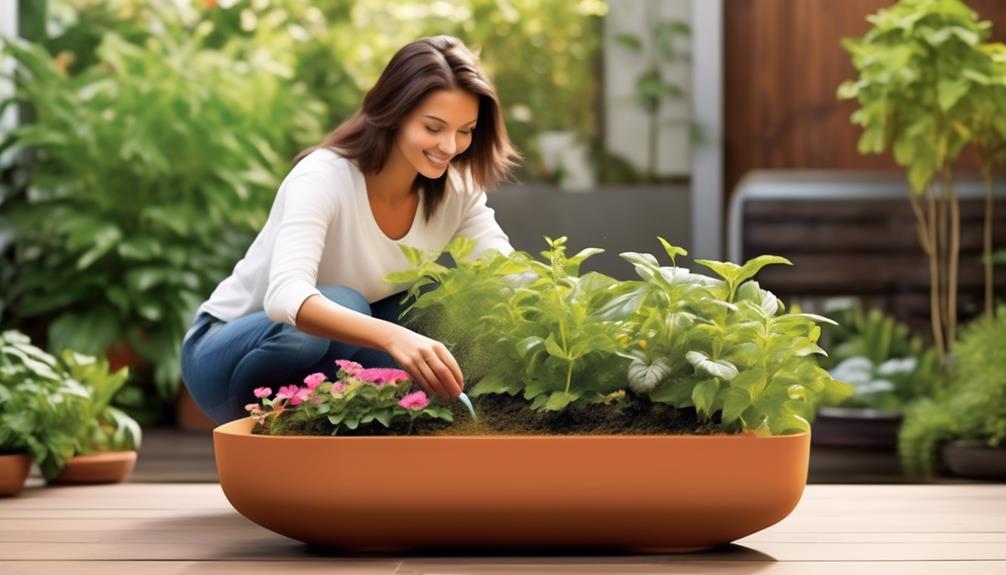
To ensure optimal growth and health of your plants, it's essential to provide them with the necessary nutrients through regular fertilization. Understanding the fertilizing schedule and the specific nutrient needs of your plants is crucial for their overall well-being.
Different plants have varying requirements for nutrients such as nitrogen, phosphorus, and potassium, so it's important to choose a fertilizer that meets these needs. A balanced fertilizer with equal parts of nitrogen, phosphorus, and potassium is suitable for most plants. However, it's essential to adjust the fertilizer based on the specific requirements of your plant species.
When considering the fertilizing schedule, it's important to fertilize your plants during their active growing season, typically in spring and summer. Avoid fertilizing in the dormant season, as this can be detrimental to the plants. Additionally, it's vital to follow the recommended dosage provided on the fertilizer packaging to prevent over-fertilization, which can lead to nutrient imbalances and potential damage to the plants.
Managing Drainage and Overflow
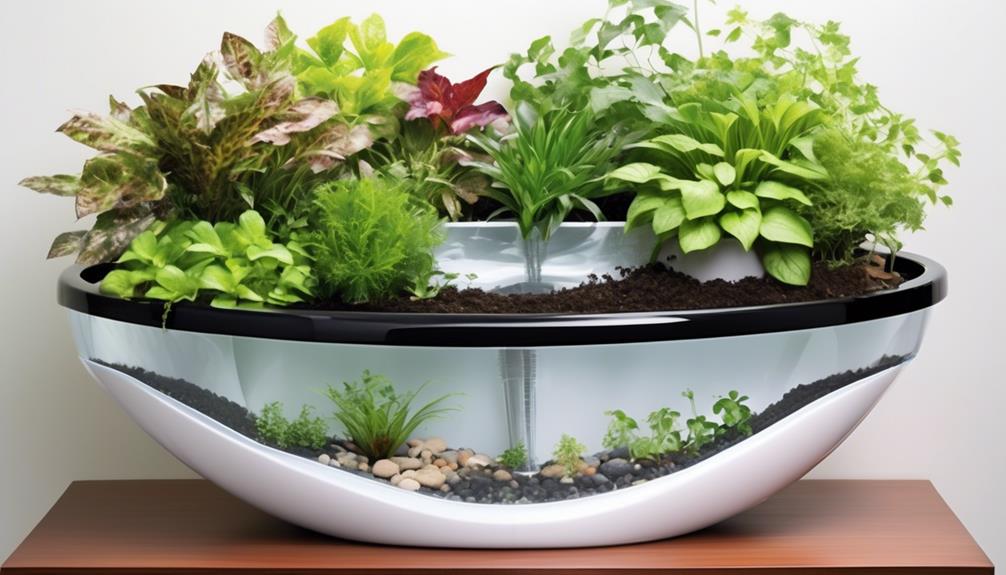
After ensuring that your plants are receiving the necessary nutrients through regular fertilization, it's important to address the management of drainage and overflow to maintain a healthy growing environment. Proper management of drainage and overflow is essential to prevent issues such as waterlogging, root rot, and mold growth. Here are three key steps to effectively manage drainage and overflow in your self-watering planter:
- Adjusting water levels: Regularly monitor the water level indicator or the soil moisture to ensure that the planter isn't overfilled. Adjust the water level based on the specific needs of your plant and the environmental conditions. This will help prevent water from accumulating in the bottom of the planter, reducing the risk of root rot and mold formation.
- Preventing mold: To prevent mold growth, ensure that the planter has adequate ventilation. Avoid overwatering, as excessive moisture can create a favorable environment for mold. Additionally, consider using a soil mix with good drainage properties to minimize the risk of mold development.
- Clearing overflow: If your planter has an overflow mechanism, regularly check and clear it of any blockages to ensure proper drainage. This will prevent water from stagnating and causing potential harm to your plants.
Troubleshooting Common Issues
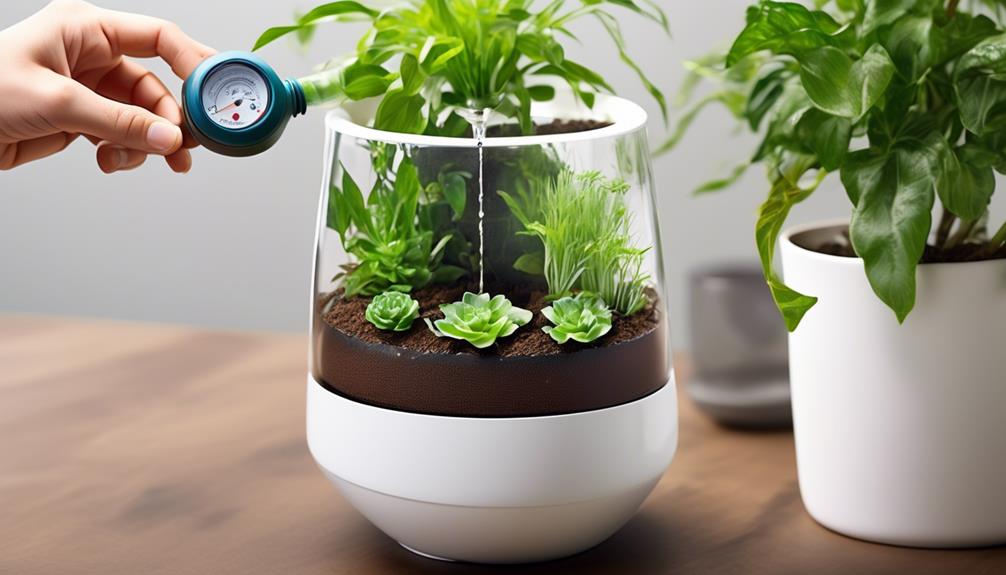
When troubleshooting common issues with a self-watering planter, it's important to methodically assess the environmental factors and plant health to identify potential causes.
One common issue is mold growth, which can occur when the planter's soil remains consistently moist. To prevent mold, ensure proper ventilation around the planter and avoid overfilling the water reservoir. Additionally, consider using a soil mix that promotes good drainage and allows air circulation.
Another common issue is overwatering or underwatering the plants. Adjusting the watering frequency is crucial to address this problem. If the soil is consistently soggy and the plants are wilting, reduce the frequency of water refills in the reservoir. On the other hand, if the soil is dry and the plants appear parched, increase the watering frequency. Monitoring the moisture level of the soil and observing the plant's condition will help in determining the appropriate watering schedule.
Frequently Asked Questions
Can Self Watering Planters Be Used for All Types of Plants, Including Vegetables and Herbs?
Yes, self-watering planters can be used for all types of plants, including vegetables and herbs. The key is to select plants that have similar water requirements to ensure they thrive.
Self-watering planters are beneficial for container gardening as they provide consistent moisture, reducing the need for frequent watering. This method promotes healthy root development and can be particularly advantageous for vegetables and herbs, leading to bountiful yields.
How Often Should I Clean the Reservoir of a Self Watering Planter?
We clean the reservoir of a self-watering planter as often as we change the oil in a car, to prevent algae buildup and keep our plants healthy.
Cleaning frequency depends on factors like plant type, climate, and water quality. Generally, we clean the reservoir every 2-4 weeks.
To prevent algae, we use a mild bleach solution or vinegar to thoroughly clean the reservoir and ensure our plants receive the best care.
Can I Use Tap Water in the Reservoir, or Should I Use Filtered or Distilled Water?
We usually use tap water in our self watering planters, as long as it's not too hard. Some plants are sensitive to mineral buildup, so a water filter might be necessary.
It's essential to monitor the watering frequency to ensure the plant's compatibility with the reservoir.
The material of the planter affects its durability and environmental impact, so it's crucial to consider these factors when choosing a self watering planter.
Are There Any Specific Maintenance Tasks I Need to Perform on a Regular Basis for a Self Watering Planter?
Regular maintenance for self watering planters is crucial for optimal plant growth. It includes checking the water level, cleaning the reservoir, and monitoring the soil moisture. These tasks ensure that the plants receive consistent hydration and nutrients.
The benefits of self watering planters are maximized through diligent upkeep. Our experience has shown that these actions promote healthy root development and overall plant vitality, making them essential for successful gardening.
Can Self Watering Planters Be Used Outdoors in Different Climates, or Are They Best Suited for Indoor Use?
Absolutely, self watering planters are designed for outdoor durability and can thrive in various climates. Their clever design ensures that they can withstand the elements while providing consistent moisture to plants.
The materials used are typically weather-resistant and can handle temperature fluctuations. This makes them well-suited for outdoor use, whether in a sunny, dry climate or a more humid environment.
Can I Use Regular Potting Soil in a Self Watering Planter?
When selecting a self-watering planter for your plants, it’s important to consider the type of soil to use. Regular potting soil can work well in self-watering planters, as these containers are designed to provide moisture to the plants from below. However, it’s crucial to learn how self-watering planters function to ensure optimal growth and prevent overwatering.
Conclusion
In conclusion, using a self-watering planter is a practical and effective way to ensure your greenery thrives.
With the right soil mix, proper planting techniques, and regular monitoring of water levels, you can create a lush and vibrant garden.
Imagine the satisfaction of seeing your plants flourishing without the constant worry of over or under-watering.
With a self-watering planter, you can enjoy a beautiful and low-maintenance garden all year round.

